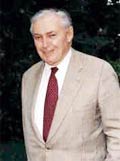Page content
A Beacon of Hope, Justice, and Resolve
Message from the President

Neither you nor I will forget the morning of September 11 and where we were when we heard the news. Business had carried me from Colonial Williamsburg to Manhattan for a meeting. I was on the fifty-sixth floor of a Rockefeller Center skyscraper when the first jetliner crashed three and a half miles away. Then the second. From the windows, we had an unobstructed view of a fireball. A tower collapsed. Our building was evacuated when the Pentagon was attacked, and we went home to follow events on television.
Between Rockefeller Plaza and Colonial Williamsburg and the World Trade Center there are connections and continuities. John D. Rockefeller Jr. launched Rockefeller Center in 1928, just as he began in earnest Williamsburg’s restoration. You probably know of the telegram he sent to authorize his first purchase of a Williamsburg house, the cryptic wire signed “David’s Father” to preserve anonymity. In the seventy-five years since, David has taken a place beside his father in the ranks of great philanthropists and businessmen. Among the distinctions on the list of his achievements is the conceptualization of the World Trade Center as part of the revitalization of lower Manhattan. I could not help reflecting on these relationships as I made my way through Rockefeller Plaza among crowds of stunned New Yorkers.
On Madison Avenue, thirty people stood around a white van listening to its radio. It must have been like that when the Pearl Harbor bulletins flashed across America. I was reminded of the death of John Kennedy, the last time I was certain I would not forget where I was when word of the unspeakable came.
Nancy and I made our way back to Williamsburg by train. The trip gave us time to reflect about the calamity, about men who build and men who destroy, about links between past, present, and future, and about the power of ideas. We knew, instantly and instinctively, Colonial Williamsburg’s duty in these difficult days: to help our visitors, our neighbors, and our nation draw fortitude and faith from the lessons of the history we have in common, from the ideas fostered here, from the lessons still taught here. Colonial Williamsburg is a beacon of the hope, the justice, and the resolve on which our democracy relies, a repository of the memory of America’s first principles.
During the days after our return to Williamsburg, foundation friends began to write. Two letters from California stood out. One was from Royce and Kitte Baker. They said, “We all have the responsibility to ensure that young people of today and future generations learn the meaning of freedom and strength that is demonstrated every day at Williamsburg. So we want to support the Campaign for Colonial Williamsburg, and a check for $1,000,000 is enclosed for that purpose.” The second was from educator Sandra Gonnerman, a Teacher Institute graduate. She said, “The time spent learning there last summer and thinking about the heritage of our country has given me hope and strength.” The generosity of spirit reflected in these letters has moved all of us here.
The Historic Area stands for a philosophy, for the idea that reason can rule a nation built on the idea of liberty and the principle of individual rights. The potential to share the experience of that idea, that principle, has never been greater. Colonial Williamsburg has never been more alive, more vital, or more needed to teach “That the future may learn from the past.”

Colin G. Campbell
President
